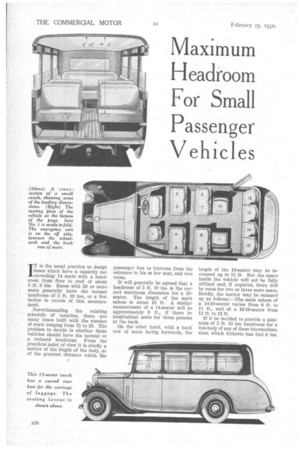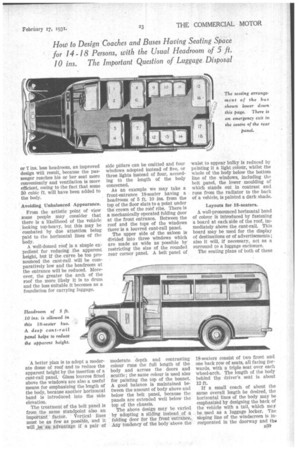Maximum Headroom For Small Passenger Vehicles
Page 66

Page 67

Page 68

If you've noticed an error in this article please click here to report it so we can fix it.
IT is the usual practice to design buses which have a capacity not exceeding 14 seats with a headroom from floor to ,roof of about 5 ft. 3 ins. Buses with 20 or more seats generally have the normal headroom of 5 ft. 10 ins., or a few inches in excess of this measurement.
Notwithstanding the existing schedule of taxation, there are many buses built with the number of seats ranging from 15 to 19. The problem to decide is whether these vehicles should have the normal or a reduced headroom. From the practical point of view it is chiefly a matter of the length of the body, or of the greatest distance which the passenger has to traverse from the entrance to his or her seat, and vice versa.
It will generally be agreed that a headroom of 5 ft. 10 ins, is the correct maximum dimension for a 20seater, The length of the main saloon is about 13 ft. A similar measurement of a 14-seater will be approximately 9 ft., if there be longitudinal seats for three persons at the back.
On the other hand, with a back row of seats facing forwards, the length of the 14-seater may be Increased up to 11 ft. But the space inside the vehicle will not be fully utilized and, if required, there will be room for two or three more seats. Briefly, the matter may be summed up as follows :—The main saloon of a 14-16-seater varies from 9 ft. to 11 ft., and of a 10-18-seater from ft. to 13 ft.
If it be decided to provide a minimum of 5 ft. 10 ins, headroom for a bus body of any of these intermediate sizes, which hitherto has had 6 ins. or 7 ins, less headroom, an improved design will result, because the passenger reaches his or her seat more conveniently and ventilation is more efficient, owing to the fact that some 30 cubic ft. will have been added to the body.
Avoiding Unbalanced Appearance.
From the artistic point of view some people may consider that there is a likelihood of the vehicle looking top-heavy, but this may be combated by due attention being paid to the horizontal lines of the body.
A well-domed roof is a simple expedient for reducing the apparent height, but if the curve be too pronounced the cant-rail will be comparatively low and the headroom at the entrance will be reduced. Moreover, the greater the arch of the roof the more likely It is to drum and the less suitable it becomes as a foundation for carrying luggage.
A better plan is to adopt a moderate dome of roof and to reduce the apparent height by the insertion of a cant-rail panel. Glass louvres fitted above the windows are also a useful means for emphasizing the length of the body, because another horizontal band is introduced into the side elevation.
The treatment of the belt panel is from the same standpoint also an important factor. Vertical lines must be as few as possible, and it will „ke:an Advantage if a pair of side pillars can be omitted and four windows adopted instead of five, or three lights instead of four, according to the length of the body concerned.
As an example we may take a front-entrance 18-seater having a headroom of 5 ft. 10 ins, from the top of the floor slats to a point under the crown of the roOf ribs. There is a mechanically operated folding door at the front entrance. Between the roof and the tops of the windows there -is a louvred cant-rail panel.
The upper side of the saloon is divided into three windows which are made as wide as possible by restricting the size of the rounded rear corner panel. A belt panel of moderate depth and contrasting colour runs the full length of the body and across the doors and scuttle ; the same colour is used also for painting the top of the bonnet. A good balance is maintained between the amount of body above and below the belt panel, because the panels are extended well below the top of the chassis.
The above design may be varied by adopting a sliding instead of a folding door for the froat entrance. Any tendency of the body above the waist to appear bulky is reduced by painting it a light colour, whilst the whole of the body below the bottom line of the windows, including the belt panel, the lower moulding of which stands out in contrast and runs from the radiator to the back of a vehicle, is painted a dark shade.
Layouts for 18-seaters.
A well-pronounced horizontal band of colour is introduced by fastening a board at each side of the roof, immediately above the cant-rail. This board may be used for the display of destinations or of advertisements; also it will, if necessary, act as a surround to a luggage enclosure.
The seating plans of both of these 18-seaters consist of two front and one back row of seats, all facing forwards, with a triple seat over each wheel-arch. The length of the body behind the driver's seat is about 12 ft.
If a small coach of about the same overall length be desired, the horizontal lines of the body may be emphasized by designing the back of the vehicle with a tail, which may be:used as a luggage locker. The sloping line of the windscreen is incorporated in the doorway and tha moulding is shaped to conform with this outline.
There will not be room for 18 seats, as in the case of the other two designs already described, owing to the presence of the rear luggage boot. Accommodation' for /5 passengers may, however, be provided in the following manner :— There is an isolated single seat beside the driver and then two rows of double seats facing forwards. The single seats over the wheelarches face one another and at the back there is a seat for four persons extending for the full width of the coach. There is an emergency exit on the off side between the wheelarch and the back row of seats, in which position it is quite conveniently placed.
With a coach it is generally pre ferred to have all the seats facing forwards, but with a small vehicle it is not advisable to make this possible at the wheel-arch position by specially raising the floor, because the height of the floor directly influences the overall height. The floor should be mounted close to the chassis and outriggers used so that the usual wood cross-bearers may be omitted.






















































































































